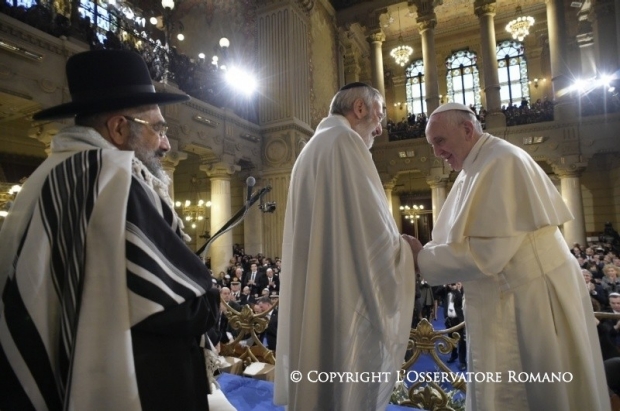We have asked Gianni Cardinale – Vatican reporter of Avvenire newspaper – to write an article on Pope Francis’s visit to the Synagogue of Rome, on 17th January 2016, in order to outline the links with Benedict XVI and John Paul II
Gianni Cardinale
19th January 2016 – “Today the Temple welcomes the third visit of a Pope and a bishop of Rome. According to the rabbinical tradition, if you do something for the third time, it becomes a chazaqà, and you get accustomed to it”. This peculiar consideration the Chief Rabbi of Rome Riccardo Di Segni made during the greeting to Pope Francis on Sunday afternoon gives the sense of the pontifical visit to the Synagogue of Rome. The tradition started on 13th April 1986, with the historical visit propitiated by John Paul II and Elio Toaff, defined as “great personalities of our time” by Ruth Dureghello, president of the Jewish Community in Rome. It was renovated on 17th January 2010 by Benedict XVI, who was kindly greeted by Ruth Dureghello. The origins of this tradition belong to Nostra Aetate, the council document that marked a turning point in the dialogue between Jews and Catholics. Pope Francis also declared that he wanted to “follow the footprints of my predecessors”. The content of his speech was similar to the speeches held in 1986 and 2010: “a ‘yes’ to the rediscovery of the Jewish roots of Christianity and a ‘no’ to every form of anti-Semitism and a condemnation of every discrimination and persecution that is derived from it”.
The Shoah teaches us that we must have “maximum vigilance, to be able to intervene quickly in defence of human dignity and peace.” “Every Pope – Di Segni said in an interview to ANSA – has his own story and style. In the relationship with Hebraism everyone showed a different sensitivity and different priorities. Benedict is above all a scholar who analysed the doctrinal features of the relationship with Hebraism. Francis is a pastoral pope, and he showed his friendship towards the Jews and their religious tradition firstly as the archbishop of Buenos Aires and then as the Pope”.
Di Segni also said with frankness that he considered that of “elder brother” an ambiguous expression, used by John Paul II during his visit. “From the point of view of the media it has got a strong influence. On the contrary, from the theological and biblical point of view it is an unsuitable expression, because in the Bible and the New Testament as, for example. the Letter of Paul to the Romans, the elder brother is seen as a bad person. It could be also interpreted as something referring to a substitution. Benedict XVI then, described the Jews as “fathers in the faith”, because he knew the previous expression could be misinterpreted.
Pope Ratzinger had explained the reasons of this choice in the interview-book entitled Light of the World. “The expression ‘elder brother’ – he had said – is not welcomed by the Jews, because the elder brother, Esaù, was considered a bad person. It expresses something important but it is better to call the Jews “fathers in the faith” to outline our relationship with them”.
In his speech, Pope Francis too used “the beautiful expression ‘elder brothers’” used by John Paul II for the first time. But he also added “You are our elder brothers and sisters in the faith”.
In spite of all, Pope Francis’s speech didn’t cause any bad reaction from the audience, and it was welcomed by a storm of applause. It showed that the relationship between Jewish world and Catholic Church are so strong that terminological differences can be easily overcome.

